Transforming Case Studies: The Art of Storytelling in Non-Tech Industries
October 29, 2024
A case study is a story about problem-solving. It is a success story, and case studies for non-technical businesses must excel at storytelling. The classic but sterile “problem-challenges-solution-results” format needs a makeover to grab and keep the attention of readers in low-tech, human-centered fields such as:
- Food & Beverage
- Real Estate and Development
- Travel
- Fashion
- Franchises*
- Education*
- Government and Non-Profit*
*Frequently non-technical
This is just a sampling of the low-tech industries that can become subjects of creatively formatted case studies.
Unlike data-driven, classically structured case studies for high-tech business readers, these case studies need a more personalized, experiential approach. Why? Because their subjects are people-centered businesses, and as such, their readers are likely seeking more subjective insights than objective facts.
Non-technical case studies for customers, clients, or personnel in these fields could aptly be renamed or reimagined as “case stories.” The structures and formats for these case studies/stories flow from integrating the elements of good storytelling into tales of business success. What are some of those elements?
First, a good story features characters—people audiences want to learn about. It tells of their thoughts, priorities, the challenges they’ve faced, and the answers they’ve found on journeys that were not always smooth.
A good story also reaches readers on an emotional level; it piques their curiosity and leaves them wondering, “What will happen next?” As the Tide business banking website states, “If they aren’t thinking that, you’ve lost them to whatever’s next on their newsfeed.”
Lastly, a good story immerses readers in the writer’s experience so they can share in it.
In his Lifehacker article, “The Science of Storytelling,” Leo Widrich explains what happens to the human brain during this sharing process:
“When we are being told a story, things change dramatically. Not only are the language parts of our brain activated, but any other area in our brain that we would use when experiencing the events of the story are, too. Anything you’ve experienced, you can get others to experience the same. Or at least, get their brain areas that you’ve activated that way, active too.”
Sharing experiences through stories creates connections, and connecting with customers is what business case stories are meant for.
Consider Your Reader When Formatting Case Studies
To connect with customers, you must first understand who they are.
Who, exactly, will be reading your case study? Where is it being published? What age group or other demographic are you targeting?
Are your readers students, professors, restaurant owners, real estate professionals, business executives, or budget-minded travelers?

Answering these questions will help you tailor your piece to fit its audience and publication.
What kind of language, tone, and level of detail will resonate with your readers? What types of images will grab their attention? Should the piece be long, short, or somewhere in between? Should it be more formal or informal?
In general, readers in more conventional industries like development, education, and government will expect solid evidence, longer text, and a more formal language and tone.
These elements will vary with specific businesses within categories like real estate, food and beverage, travel, franchises, and nonprofits, depending on the casual or more serious nature of the business and their branding.
A case study on a burger joint chain will look, sound, and feel quite different from one on a five-star fine dining restaurant. A study on a cruise line specializing in family fun adventures will likewise differ from one that offers European cultural excursions.
Examples of Case Studies That Tell Business Success Stories
Formality and Evidence for a High-Fashion Firm
Here is an example of the more conventional type, published on the MBA Knowledge Base website.
Its readers are likely corporate retail professionals seeking to tweak their firms’ business strategies to maximize profits.
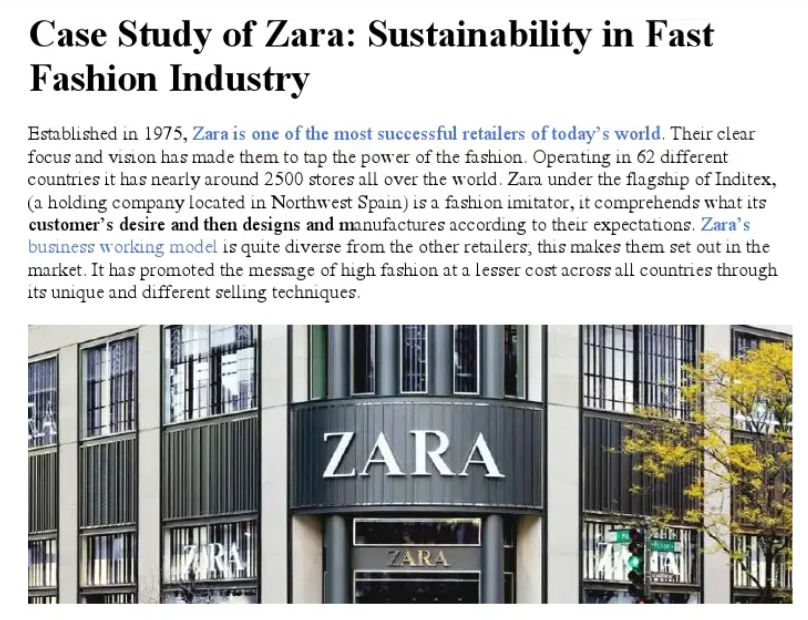
The company in the study serves the demands of its fashion-conscious customers for very personal products—the clothes they wear.
Titled “Case Study of Zara: Sustainability in the Fast Fashion Industry,” the piece details the company’s strategy to quickly discern and emulate high-fashion trends to sell at less-haute prices.
The story begins with facts that establish the fashion chain’s success: the year it started (1975), the number of countries in which it operates (62), and the number of stores it runs (2,500).
A later paragraph illustrates some of the fashion leader’s unique methods and sets a sophisticated tone:
“Their aristocratic store layout feels exclusive, as they are swish and centrally located. The company doesn’t spend much on advertising; it seeks to add value for its customers rather than spending on brand promotion. While its rivals start planning their lines, on average, nine months before they hit the shelves, Zara has a reputation for instant reactions to fashion trends and rapid restocking of stores. Zara can take a new line from initial concept to shop in just three weeks.”
One photo, showing a glitzy Zara storefront, is included, backing up the story’s “aristocratic” description. The target reader sees proof that Zara’s strategy works—encouragement to either open their own Zara store or apply the strategy within their own company.
A More Casual Look and Tone for a Barbecue Franchise
Now let’s look at an informal case study titled “Franchisee Success Story: Meg of Dickey’s Barbecue.” Published on FranchiseOpportunities.com, its likely readers are individuals looking for a great casual food business opportunity.
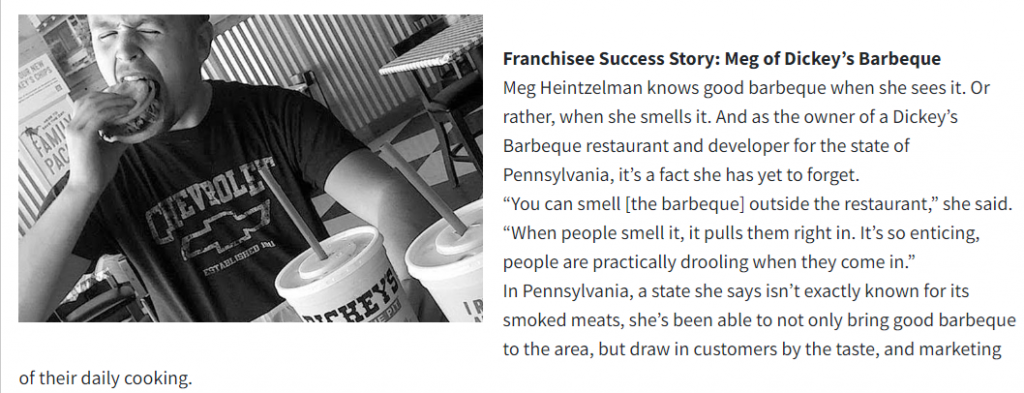
The piece tells the story of Meg Heintzelman’s Dickey’s Barbecue franchise in Pennsylvania. It opens with a photo of a young man enjoying a barbecue sandwich and adopts an easygoing, personal tone, speaking of the smell of barbecue and Heintzelman’s background.
Thoughts and quotes from the business owner about meeting and overcoming challenges are part of the story, as in this excerpt:
“After introducing barbecue into an area that wasn’t aware barbecue could be anything other than pork, she said there are now almost equal sales of beef and pork. Though her personal favorite is the chicken: ‘It’s like no other chicken you’re going to find; it’s just heavenly.’ Now in her seventh year, Heintzelman’s loyalty remains strong. ‘It’s kind of taken the country by storm. Have a great product, a great price point,’ she said. ‘If I have success at this, it’s because I have so much belief in the brand.’”
Through Meg’s description, readers are immersed in the taste experience customers would enjoy at their own future franchises, and they can hope to share in her success, too.
Compelling Non-Techy Case Study Formats
Below are three effective storytelling formats to consider emulating for your next published case study.
1. An Article-Style Story That Leads With a Current Trend
This type of study/story points to a trend and then shows how a business has taken advantage of it to position itself well in the industry.
The US Builders Review (USBR) website features excellent real estate development-related case studies that use an informative article format to illustrate successful company responses to trends.

For its case story on Southeast developer Lat Purser & Associates, USBR begins, “Thanks to millennials, there’s a trend afoot: walkability.
Walkability is a measure of how ‘friendly’ a neighborhood is to walking.
In an ideal scenario, employment, shopping, dining, and entertainment can all be accessed on foot rather than by car.”
The article provides some company history followed by quotes from Lat Purser’s president, Bob Otten, who explains how his firm has successfully boarded the walkability bandwagon with multifamily developments.
Otten states that Lat Purser places its developments near workplaces, grocery stores, restaurants, and entertainment, targeting millennials who prefer walking to driving.
Section headings like “Walking the Talk, Talking the Walk” and “True to Its Roots” replace the traditional “Solutions” and “Results” headings used in conventional case studies. The article’s relaxed yet detail-rich writing style is appropriate for its likely readers—industry insiders.
Which current trend is your company seeing and taking advantage of? Whatever it is, it could be a candidate for a trendy case study formatted in an article style.
2. A Personalized Business Success Story
Each of the travel advisor case studies on the Travefy website focuses on a main character—a travel advisor—and recounts their journey to success using Travefy’s systems.
The lead case study, “Perfect for the Perfectionist,” introduces travel advisor and Ebony Vacations owner Cher Bell.
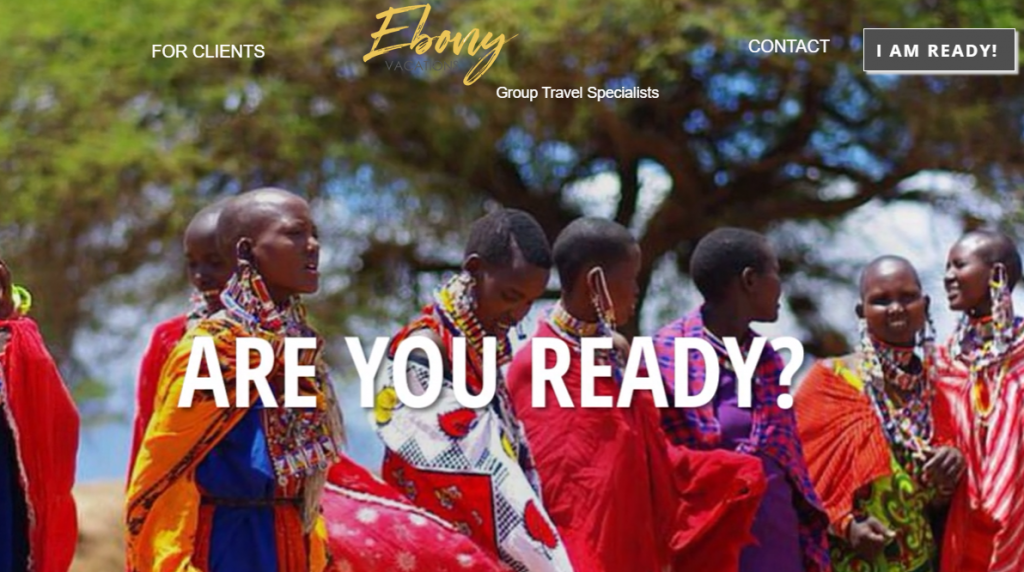
The reader (a potential Travefy client) is drawn into Cher’s story with a heartfelt opening about the love of travel that inspires many agents to choose their career.
Cher tells readers, “I believe my wanderlust began at a very young age as a military brat traveling the world with my family. I quelled my thirst for travel and experiencing amazing adventures by creating customized itineraries for my family and friends.”
The story recalls the problem: Cher’s “obsessively detail-oriented” nature led her to spend excessive hours preparing trip quotes and itineraries.
With Travefy (the solution), she says she can “pull in information, websites, etc., from many destinations all over the world!”
Travefy enabled links to her website and reservation page, and using its tools helps her save time on quote and itinerary creation—time she now dedicates to activities that help grow her business. That spells “success” for Cher.
Can a client’s personal success story highlight what your business does well?
3. A Brief, Thought-Provoking Story That Shows and Tells
“A picture is worth a thousand words,” right? That maxim holds true in a case study about the Liqui Group’s interior design strategy for Verdi Italian Restaurant.
The story’s text, in just two info-packed paragraphs, is far fewer than 1,000 words. It’s just long enough to spell out how Liqui created branding and interior design that work together.
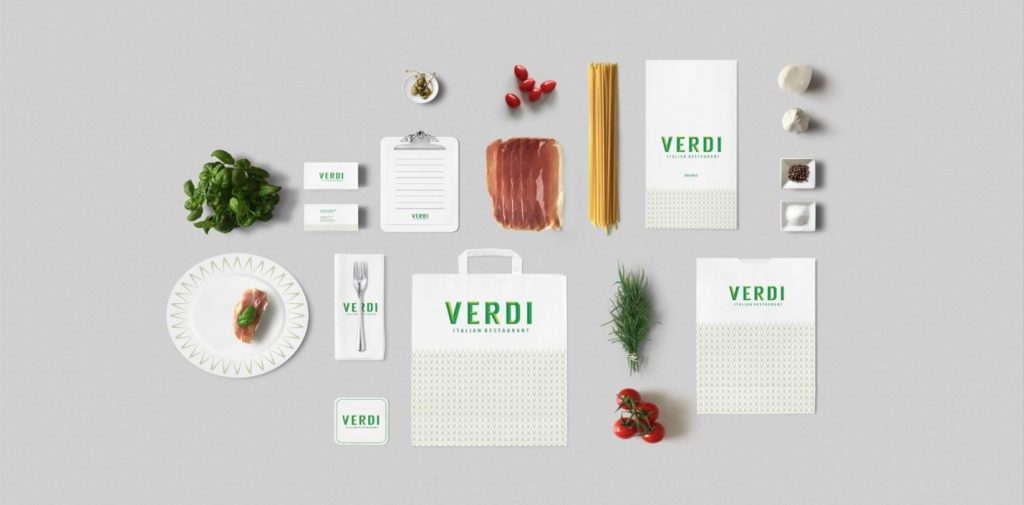
The process began with choosing a color and a name. Since the restaurant emphasized “fresh, quality produce,” the name “Verdi (meaning ‘greens’),” was chosen, says Liqui.
Varying shades of green were used in both the branding and design plan—from the logo to the green-infused interior design theme that integrated feathery hanging plants.
The short story is really brought to life with a profusion of vibrant photos and a couple of planning-phase drawings; images essential to completing the story of Liqui’s success at Verdi.
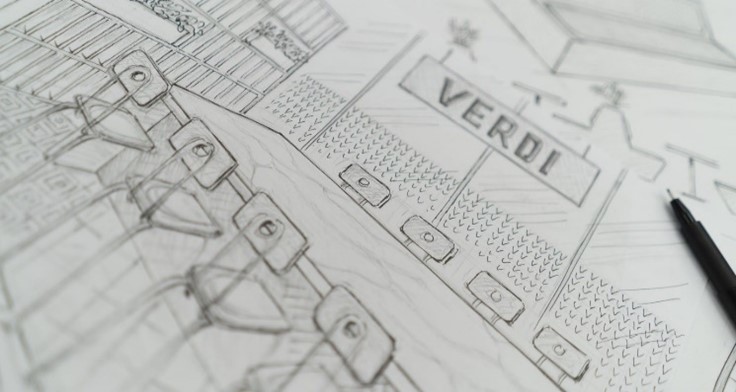
Will this tell-less, show-more method of storytelling work well for case stories about your client’s successes?
The possibilities are endless
The non-technical case study formats shown above are just a starting point. Formatting possibilities are only limited by the imagination that you, your staff, or a visionary writing agency bring to a project. There are so many ways to tell a compelling case story to non-techy readers.






























